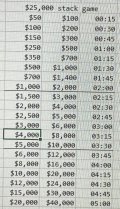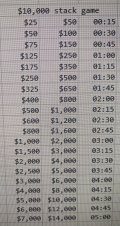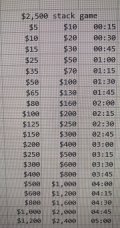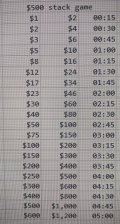Thanks Justin. I think I'm going to go with 15/12/9/2. This will only require getting one more barrel of $5s along with the new $1s. And I could try dropping to T400 also. Agreed, it may not be the most playable, but it's all about the chips, right?Not sure what the quantities in your full set would be, but if you can do 20/16/12 you can probably also do 15/17/8/1 or 10/12/9/1 if T500 is your number without adding T5 chips. Personally I think you could probably start as low as T400 with blinds starting at 1-2 and still have plenty of play. I do think other base units are better of course, but this is certainly playable for the sake of the set if that's the mission of course.
You are using an out of date browser. It may not display this or other websites correctly.
You should upgrade or use an alternative browser.
You should upgrade or use an alternative browser.
Tourney Anyone have advice for playing T1 base tournaments? (1 Viewer)
- Thread starter TX_Golf_N_Poker
- Start date
deeoohhgee
High Hand
agreed ... just for example, here are four example tourney structures that are essentially the same, just "multiples of each other" ... this may be a contentious position but •it doesn't matter• if you design the tourney structure well ... i get it though, players want to have "big denom chips" when the betFind a T100 structure you like. Remove two zeros. Done.
Attachments
agreed ... just for example, here are four example tourney structures that are essentially the same, just "multiples of each other" ... this may be a contentious position but •it doesn't matter• if you design the tourney structure well ... i get it though, players want to have "big denom chips" when the bet
As @BGinGA already pointed out T100 is not analogous to T1. I see this misconception a lot on PCF. If you divide T100, T500, T1000, T5000, T25k by 100 you get T1 T5, T10, T50, T250...those last 3 denoms do not exist in most chipsets.
I have only run a few casual tournaments, single table, but 2 of them were base T1. And they were a blast. I was (still am) a total noob in running tournaments, but in the event it is helpful, here is how I structured it.
I used T250 stacks of 15/12/7.
This structure has multiple big jumps, which is normally not advised. (I did not know any better). But functionally it worked well and is kind of like 3 mini tournaments in one:
1. Play for an hour as base 1 with 20min levels of 1/2, 2/4, 3/6. Then break and color up. This break is only chance to rebuy.
2. Play again for an hour as base 5 with 15 min levels of 5/10, 10/20, 15/30, 20/40. Then break and color up.
3. Play again for an hour as base 25 with 15min levels (25/50, 50/100, 75/150, 125/250). Break. No color up.
4. Then 10 min levels of 200/400, 300/600, 400/800, etc. till game over.
I think this structure was easy for noobs to conceptualize and gets them used to T5 and T25 base structure as well. And a few 100s make it to the table during color ups.
Games were over around 3.5 hours (perfect for a bunch of working dads needing to get home before midnight and to work next day). If you want the game to go longer just add more 25s to the starting stacks or allow add ons.
Oh, and my payout structure was unorthodox but also very noob friendly. For 7 or 8 handed: third place got money back, second doubled money, first got rest of pot. For 9 or 10 players: third got money back, second tripled, and first got rest of pot.
This payout system breaks down if you have multiple add ons, re-buys, or more than 1 table.
This payout system breaks down if you have multiple add ons, re-buys, or more than 1 table.
deeoohhgee
High Hand
fair point about "straight dividing" & it is true ... there is •some• tweaking of blind increases necessary when scaling but it's still quite doableAs @BGinGA already pointed out T100 is not analogous to T1. I see this misconception a lot on PCF. If you divide T100, T500, T1000, T5000, T25k by 100 you get T1 T5, T10, T50, T250...those last 3 denoms do not exist in most chipsets.
I have only run a few casual tournaments, single table, but 2 of them were base T1. And they were a blast. I was (still am) a total noob in running tournaments, but in the event it is helpful, here is how I structured it.
I used T250 stacks of 15/12/7.
This structure has multiple big jumps, which is normally not advised. (I did not know any better). But functionally it worked well and is kind of like 3 mini tournaments in one:
1. Play for an hour as base 1 with 20min levels of 1/2, 2/4, 3/6. Then break and color up. This break is only chance to rebuy.
2. Play again for an hour as base 5 with 15 min levels of 5/10, 10/20, 15/30, 20/40. Then break and color up.
3. Play again for an hour as base 25 with 15min levels (25/50, 50/100, 75/150, 125/250). Break. No color up.
4. Then 10 min levels of 200/400, 300/600, 400/800, etc. till game over.
I think this structure was easy for noobs to conceptualize and gets them used to T5 and T25 base structure as well. And a few 100s make it to the table during color ups.
Games were over around 3.5 hours (perfect for a bunch of working dads needing to get home before midnight and to work next day). If you want the game to go longer just add more 25s to the starting stacks or allow add ons.
Yahooligan
Sitting Out
Does anyone know the history of why tournaments typically base chip starts at 25/50 or 100 instead of T1? Is it just to cause some separation from cash games? Make the denominations feel higher/more exciting?
It seems like as long as the BB to Total starting count size is the same, it doesn't really matter.
It seems like as long as the BB to Total starting count size is the same, it doesn't really matter.
JustinInMN
4 of a Kind
My theory is that when the Moneymaker boom happened, the format of the WSOP main event was 10,000 in starting chips with blinds starting at 25-50. When other poker rooms wanted to do tournaments, they emulated that formula. Eventually the WSOP decided to with larger starting stacks, big blind ante, and found that base T100 was more conducive to these changes, and again, rooms are starting to emulate this.Does anyone know the history of why tournaments typically base chip starts at 25/50 or 100 instead of T1? Is it just to cause some separation from cash games? Make the denominations feel higher/more exciting?
It seems like as long as the BB to Total starting count size is the same, it doesn't really matter.
The main event was originally played with cash chips. You bought in for $10k and got $10k in chips. And it was winner take all for a while. I’m not sure if the other WSOP tournaments were originally the same starting stacks equal real dollars situation, but I bet they were.Does anyone know the history of why tournaments typically base chip starts at 25/50 or 100 instead of T1? Is it just to cause some separation from cash games? Make the denominations feel higher/more exciting?
It seems like as long as the BB to Total starting count size is the same, it doesn't really matter.
In recent years we’ve seen tournaments move from standard base T5 to T25 to T100. And of course it doesn’t matter. Plenty of PCFers like to do T500 or T1000 (which in my opinion is unnecessarily ostentatious, but I have a lot of opinions.)
My question would be this - did they invent the tournament format for the WSOP, or did it exist before that?
I think it's just a psychological thing. No matter what the actual cash buy in is, would you rather have 2000 chips, 10000 chips, or 50000 chips in front of you? Bigger numbers make people feel like bigger gamblers.
Personally I’m somewhere between I don’t care and the smaller amount. I honestly don’t care - your stack is simply a bunch of big blinds, the numbers don’t matter. Except that when you have big stupid numbers, you have to announce big stupid bets. Would you rather say “fifteen thousand” or “one point five million?” I’m fifteen thousand all day.I think it's just a psychological thing. No matter what the actual cash buy in is, would you rather have 2000 chips, 10000 chips, or 50000 chips in front of you? Bigger numbers make people feel like bigger gamblers.
- upndown, ever the contrarian.
JustinInMN
4 of a Kind
There is a point of diminishing returns on this and @upNdown 's point is part of the reason for sure.I think it's just a psychological thing. No matter what the actual cash buy in is, would you rather have 2000 chips, 10000 chips, or 50000 chips in front of you? Bigger numbers make people feel like bigger gamblers.
Even the rubiest of rubes know that 50, 50-thousand, and 50-million are only meaningful numbers relative the blinds. Bigger numbers for bigger sake alone has a limit.
That said, I think having tournaments in whole numbers makes a lot of sense. I do think it makes some sense to use somewhat large numbers a$s most individuals are better at counting by fives and twenty-fives than by ones.
It's really more about the spacing between the denominations you use and how efficiently they can represent a players tournament "score" than just doing big numbers for the sake of it.
Yahooligan
Sitting Out
You're the thought leader here and I like the strength of the opinion formed. A few follow up questions:I don't particularly like T1-base events, mostly because they quickly run into the same bet size unfamiliarity issues faced by T5-base tournaments. If they are the only option (due to chip set constraints) they can work (however suboptimally), but I don't recommend either.
How big of a hindrance is a T1 vs. T25 really? It seemed as if the action was cooler with the lower base.
Any difference between T1 & T5 base? (I'm guessing no).
You're the thought leader here and I like the strength of the opinion formed. A few follow up questions:
How big of a hindrance is a T1 vs. T25 really? It seemed as if the action was cooler with the lower base.
Any difference between T1 & T5 base? (I'm guessing no).
Heck, you can even do a T0.25 base if you want. That allows most people here to use their existing cash sets as tourneys, as long as they have good structure and enough chips to do starting stacks and colour-ups.
I see nothing wrong with a T0.25 base T100 tourney. Uses a T25 base T10k structure and divide all numbers by 100.
Yahooligan
Sitting Out
This is an interesting idea as well.Heck, you can even do a T0.25 base if you want. That allows most people here to use their existing cash sets as tourneys, as long as they have good structure and enough chips to do starting stacks and colour-ups.
I see nothing wrong with a T0.25 base T100 tourney. Uses a T25 base T10k structure and divide all numbers by 100.
As addressed earlier, T1- (and T5-base) structures include a number of blind levels where the bet size math is not easily handled by players. Increments of 25 and 100 are much easier for most human brains than are multiples of 5.You're the thought leader here and I like the strength of the opinion formed. A few follow up questions:
How big of a hindrance is a T1 vs. T25 really? It seemed as if the action was cooler with the lower base.
Any difference between T1 & T5 base? (I'm guessing no).
Another downside of T1- and T5-base sets is the larger number of small-denom starting chips needed to promote smooth game play. Most use inferior 10/10/x stack breakdowns, when 15/15/x stacks are actually much better for play. T.25- and T25-base sets can use smaller 12/12/x stack breakdowns to achieve similar results, resulting in a more efficient set with better chip distribution across the larger denominations.
Absolutely. The T.25 set also totally bypasses the odd 2x tourney chip jump from T500-T1000, and allows the use of $20/T20 chips in lieu of $25/T25 if desired. Many more T5s will be needed than typical T500 numbers, but this usually isn't an issue for most cash sets and $5 chips.Heck, you can even do a T0.25 base if you want. That allows most people here to use their existing cash sets as tourneys, as long as they have good structure and enough chips to do starting stacks and colour-ups.
I see nothing wrong with a T0.25 base T100 tourney. Uses a T25 base T10k structure and divide all numbers by 100.
Yahooligan
Sitting Out
Super helpful info to hone in on ideal starting stack from a smooth gameplay + efficiency consideration.Most use inferior 10/10/x stack breakdowns, when 15/15/x stacks are actually much better for play. T.25- and T25-base sets can use smaller 12/12/x stack breakdowns to achieve similar results, resulting in a more efficient set with better chip distribution across the larger denominations.
Similar threads
- Poll
- Replies
- 8
- Views
- 326
- Replies
- 33
- Views
- 1K
- Replies
- 14
- Views
- 1K
- Replies
- 13
- Views
- 535




